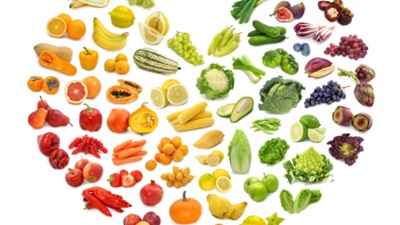
The colors of the rainbow aren’t just pretty in the sky, or on the faces of people going by, as Louis Armstrong refers to in his iconic song, What a Wonderful World.
Those colors also promote healthy foods on your plate. When I say color I don’t mean your ketchup, mustard, and relish. The daily consumption of whole fruits and vegetables from a variety of colors do more for you than just look pretty. From colorful, healthy foods, you get a wide range of vitamins, minerals, antioxidants, which are very important for your body’s daily function and overall health.
Different Colors with Different Benefits
1. Red & Bright Pink
Your typical red foods include apples, bell peppers, cranberries, tomatoes, while bright pink would be pink grapefruit, watermelon, onions and beets.
The benefits of these healthy foods are very significant, with lycopene being the major pigment in red vegetables and fruits. Also, keep in mind that cooking your food enhances the activity of lycopene, which is a phytochemical. Lycopene helps reduce the risk of heart disease and various cancers such as prostate and breast.
These bright colored foods contain essential minerals and vitamins such as vitamin A, vitamin C, folate, and potassium—all important nutrients for your healthy eating plan.
Red healthy foods also contain flavonoids, which have antioxidant properties and can help reduce inflammation.
2. Orange & Yellow
Orange and yellow healthy foods are also important for reducing the risk of heart disease and some types of cancer such as in the stomach, esophagus, and the lungs. That’s because of beta carotene, which is found in orange veggies and fruits.
They may also improve immune function, and help slow down the aging process. Sounds like you should add these brightly colored healthy foods to your healthy eating plan!
When it comes to your eyesight, you want to eat orange and yellow foods because they have vitamin A, vitamin C, and omega-3 fatty acids.
The carotenoids in orange foods (alpha carotene, beta cryptoxanthin, and beta carotene) are converted into vitamin A by your body.
Examples of orange healthy foods are apricots, oranges, cantaloupe, sweet potatoes, pumpkins, peaches, carrots, yams, orange bell peppers, and winter squash. Your yellows include corn, lemons, summer squash, and yellow peppers.
3. Green
Green veggies and fruits also promote healthy vision because of the richness in the antioxidant lutein, which helps protect against age-related macular degeneration in the eyes. Having healthy eyes should be at the top of your healthy eating plan—and eating green foods is essential!
Lutein, found in leafy green veggies, also reduces the risk of heart disease and breast cancer. Your dark leafy greens are also important for strong bones with calcium and oxygen transport with a good source of iron.
A variety of green healthy foods include honeydew melons, avocado, kiwifruit, pistachios, broccoli, Brussels sprouts, lettuce, kale, spinach, parsley, and other leafy greens.
4. Blue & Purple
Feeling blue? Have some blue and purple foods, which are your blueberries, blackberries, pomegranates, eggplant, grapes, prunes, and plums.
Blue foods containing anthocyanins (antioxidants) is like your shield, helping protect against heart disease and preserving your memory. Blueberries have the most antioxidants than any other healthy foods.
Blue and purple produce such as eggplants also contain a lot of iron. This also helps oxygen power your brain and other vital organs. Blue and purple foods also contain lutein and zeathin, reducing your risk of macular degeneration.
5. White & Beige
White processed foods should mostly be avoided for your healthy eating plan; however, white produce should be praised.
They have the antioxidant allicin, which reduces the risk of stomach cancer, and stabilizes blood cholesterol and blood pressure. This indicates that foods such as cauliflower and ginger can reduce your risk of heart disease. White produce are also rich in B vitamins, riboflavin, and niacin, which benefit your digestion.
What are other healthy white and beige foods? They include plants such as mushrooms, onions, and potatoes, as well as healthier grains (brown rice), nuts, seeds, and beans.
Consider a variety of color with your meal preparation. These healthy foods should be part of your healthy eating plan. When you incorporate every color of the rainbow into your food, your great health becomes the “pot of gold’ at the end of those bright colors.
Sources:
Schaeffer, J., “Color Me Healthy—Eating for a Rainbow of Benefits,” Today’s Dietitian: The Magazine for Nutrition Professionals, November 2008; http://www.todaysdietitian.com/newarchives/110308p34.shtml.
Coffman, M., “Healthy Colors of Foods,” SFGate web site; http://healthyeating.sfgate.com/healthy-colors-foods-3355.html#.
Dupont, C., The New Enlightened Eating: Simples Recipes for Extraordinary Living (Summertown: Books Alive, 2012), 8.
“Nutrition to Reduce Cancer Risk,” Stanford Cancer Center web site; http://cancer.stanford.edu/information/nutritionAndCancer/reduceRisk/.













